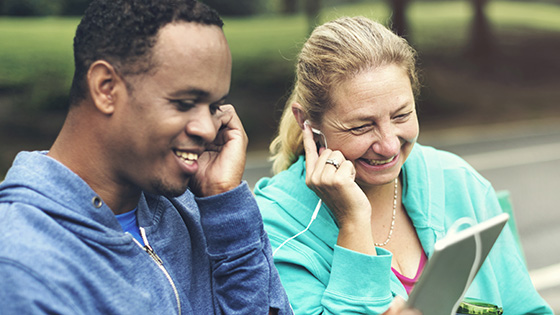How Rendia is empowering patients who have irreversible vision loss
This is the second half of a two-part series in honor of Meet the Blind Month.
Months ago, a few members of the Rendia team met with the National Federation of the Blind to learn how we could support one another. During our meeting, we learned how many patients first learn they’re going blind, and how the message is frequently one of hopelessness and tragedy. This message was in stark contrast to what we witnessed at the NFB: blind employees leading meetings, non-sighted coworkers making weekend plans together, hallway walls decorated with photos of blind people enjoying activities such as horseback riding and fishing.
Our team was so moved by our experience at the NFB that we decided to create a video that would tell a hopeful, empowering message to patients losing their vision.
Researching the patient’s perspective
As with all of Rendia’s content, we started our script and animation process with research. We came across amazing stories from the perspectives of people who had lost their sight, which helped us relate to our target audience. Some of our favorites include:
- Joy Ross’s YouTube channel, where Joy records her daily life from her non-sighted perspective. She shows everything from running errands with her guide dog, putting on makeup, navigating an airport, and using apps that can identify fruits and vegetables at the grocery store.
- Daniel Kish’s amazing TED talk, where he shows how he uses clicking with his tongue – a type of echolocation – to navigate the world around him without sight.
- Nicole Kears shares her inspirational story about coming to terms with her vision loss
- This interview of Marc Riccobono of the NFB and Stacey Cervenka of the Blind Traveler’s Network discussing their ideas for how travel can be made easier for people who are blind.
Resources we found
As we researched resources for the blind, we were better able to appreciate how tried-and-true techniques, such as learning to read Braille or using a cane or a guide dog, can make an instrumental difference in fostering independence for people with low or no vision.
Learn how relying on technologies leads to fewer people with vision impairment learning Braille and increases in illiteracy
We also learned about technologies available to support the blind. A few years ago, Rendia made an animation for people with low vision to let them know about these devices, such as magnifiers and screen reading technology. What’s more, the realm of assistive technologies is evolving and changing in the digital age. Some of the emerging technology aimed to help people with low or no vision that we came across include:
- Aipoly Vision app, Microsoft’s SeeingAI, and Google’s Lookout app (coming soon) use artificial intelligence to recognize objects that surround you
- Sunu is a wristband that uses vibrations to let you know how close you are to surrounding obstacles
- Be My Eyes and Aira are mobile apps that pair you with a person on demand who will provide visual assistance through a live video call
- eSight and NuEyes are glasses that enhance incoming images by letting you control magnification and contrast
Although these devices are still in the early stages, the possibilities for technology to further advance autonomy for blind persons are encouraging.
Getting the message right
Once we were able to better understand what someone goes through when learning their vision cannot be restored, we knew that the message first and foremost needed to show compassion. At the same time, the video needed to be empowering and hopeful. We wanted to make it clear that there are many resources available and a variety of ways to thrive as individual without sight.
While planning the storyboard for the video, animator Matthias Egger said, “I’ve animated countless videos about health conditions before, and usually it’s pretty straightforward once you understand the science. But once I started working on this video, I realized it was one of the most important videos I’ve ever made because I wasn’t just explaining pathology; I needed to give someone hope after receiving devastating news.”
“Once I started working on this animation, I realized it was one of the most important videos I’ve ever made,” said animator Matthias Egger.
One of the hardest parts of the animation was choosing imagery that conveyed the goals of the video. Egger was inspired by the image of a butterfly, which appears throughout the video as a symbol of beautiful transformation. The images of people featured in the video were also carefully selected. We felt that it was important to show a diverse array of people enjoying all facets of life – gardening, playing music, exercising, spending time with family – and using various resources, such as Braille, a guide dog, or a cane.
We knew that the video would not only be important for the patients themselves, but also their loved ones who may be wondering how they can best support their family member.
Watch the video here:
We are sharing this video (with audio descriptions) with the NFB to get the message out to more people who learn they are losing their vision. In addition, all of Rendia’s eye care subscribers have access to the video in their library, to help them support patients through the transition and be a source of support.
If you’d like to learn more about how Rendia is working to transform the patient experience, check out our website at get.rendia.com.


